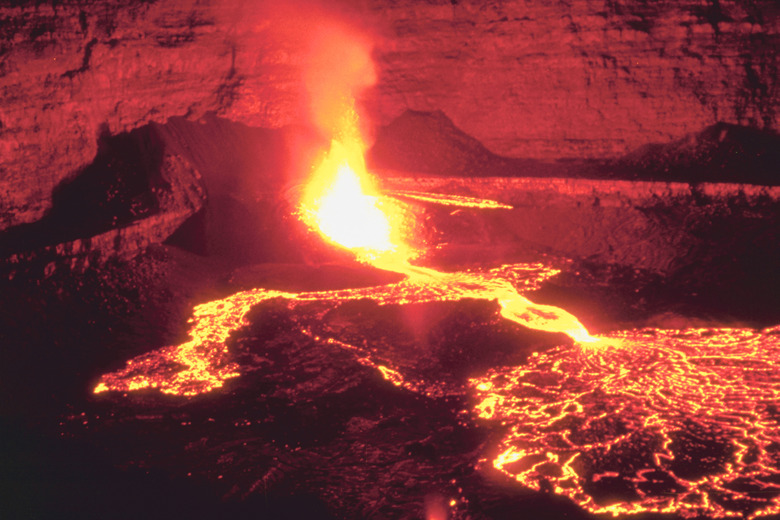Differences Between Extrusive And Intrusive Rocks
Rocks form when mineral compounds react with heat, water or pressure. Intense heat that liquefies inside the Earth makes hot molten material called magma. Lava is magma that pushes up through the Earth's crust to the surface. When magma and lava cool and harden, they create igneous rocks. These rocks may be extrusive or intrusive, depending on where the magma or lava crystallizes. Basalt is the most common extrusive rock while granite is a very common intrusive rock.
TL;DR (Too Long; Didn't Read)
Extrusive igneous rocks come from lava, forming at the surface of the Earth and cooling quickly, meaning they form very small crystals. Intrusive igneous rocks come from magma, forming deep underground and taking longer to cool, meaning they form larger crystals.
Rock Formation
Rock Formation
Extrusive rocks and intrusive rocks both form when hot molten material crystallizes. However, extrusive rocks form from lava at the surface of the Earth, whereas intrusive rocks form from magma underground, often relatively deep in the Earth. A pluton is a block of intrusive igneous rock. A large pluton may be a batholith or a stock while smaller plutons include dikes and sills. A dike is a penetrating intrusion that cuts across the geological layers. A sill is a penetrating intrusion that runs parallel to the layers. A laccolith is an intrusion that causes rocks above to rise in a dome shape.
Cooling Time
Cooling Time
Extrusive rocks cool quickly because they are at the surface of the Earth. Intrusive rocks take a lot longer to cool because the temperature under the Earth's surface is a lot higher. Extrusive rocks usually last much longer in the destructive environment at the earth's surface because they formed there. Intrusive rocks typically break down quickly when exposed to the elements because it is not their natural habitat.
Crystal Size and Texture
Crystal Size and Texture
The most obvious difference between extrusive rocks and intrusive rocks is crystal size. Because extrusive rocks cool quickly, they only have time to form very small crystals such as basalt or none at all. On the other hand, intrusive rocks grow larger crystals because they take longer to cool. Extrusive rocks are usually fine-grained or glassy while intrusive rocks are coarse-grained. Extrusive rocks may contain trapped bubbles of gas called vesicles.
Mineral Proportions
Mineral Proportions
You can break all igneous rocks into four main types, regardless of whether they are extrusive or intrusive rocks. They may be felsic, intermediate, mafic or ultramafic, depending on the ratio of light minerals to dark minerals. Felsic rocks, like rhyolite and granite, are high is silica, one of the most common elements on Earth. Intermediate rocks, like andesite/dacite and diorite/granodiorite, have a lower silica content and are darker than felsic rocks. Mafic rocks, like basalt and gabbro, have low silica content but contain iron and magnesium, Ultramafic rocks, like peridotite, contain very little silica and lots of iron and magnesium.
Cite This Article
MLA
Gillespie, Claire. "Differences Between Extrusive And Intrusive Rocks" sciencing.com, https://www.sciencing.com/differences-between-extrusive-intrusive-rocks-10017336/. 13 April 2018.
APA
Gillespie, Claire. (2018, April 13). Differences Between Extrusive And Intrusive Rocks. sciencing.com. Retrieved from https://www.sciencing.com/differences-between-extrusive-intrusive-rocks-10017336/
Chicago
Gillespie, Claire. Differences Between Extrusive And Intrusive Rocks last modified March 24, 2022. https://www.sciencing.com/differences-between-extrusive-intrusive-rocks-10017336/
